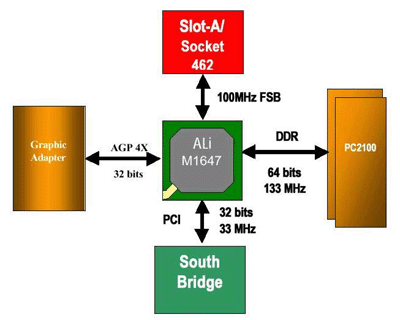ALi MAGiK 1: The Athlon gets a second DDR platform
by Anand Lal Shimpi on November 29, 2000 3:07 AM EST- Posted in
- CPUs
ALi works MAGiK
The MAGiK 1 chipset is split into the M1647, what ALi likes to call the Athlon Super Northbridge and one of ALi’s Southbridge chips, the flagship solution being the M1535D+ Southbridge.

The M1647 Northbridge, for starters, supports both the 200 and 266MHz FSB frequencies for the Athlon’s EV6 bus. The actual operating frequency of the FSB is 100 or 133MHz, however the bus transfers data twice on every clock yielding the 200/266MHz figures we just stated.
Just as with the AMD 760, the MAGiK 1 chipset requires that the FSB be run synchronously to the memory bus. Allowing for asynchronous operation with a DDR memory subsystem puts a very heavy burden on the motherboard manufacturers as it isn’t a simple task to accomplish, thus ALi simply limits all memory clocks to be synchronous with the FSB clock. This means that with a 200MHz (100MHz DDR) FSB, the memory clock must be set to 100MHz as well, and for a 266MHz (133MHz DDR) FSB, the memory clock must run at 133MHz.
Since the memory bus on the MAGiK 1 is DDR as well, things work out perfectly since the FSB and memory bus operating frequencies end up equaling each other. This also translates into the exact same amount of bandwidth available to/from the CPU as there is to/from the memory subsystem.
With two officially supported memory bus frequencies 200/266MHz (100/133MHz DDR) to accompany those supported FSB frequencies, the MAGiK 1 supports the two major types of DDR SDRAM: PC2100 (266MHz) and PC1600 (200MHz). As the names imply, they offer 2.1GB/s and 1.6GB/s of peak available memory bandwidth respectively.
As is the case with all other forms of DRAM, there are currently different ratings of these modules available which are differentiated amongst according to their CAS latency. Currently, PC1600/2100 SDRAM is offered in CAS2 and CAS2.5 varieties, CAS2 being the lower latency and the higher performing solution. Finding CAS2 PC1600 SDRAM is fairly simple, however finding anything other than CAS2.5 PC2100 SDRAM is currently next to impossible. The MAGiK 1’s memory controller supports both types of DDR SDRAM, and most motherboards will allow you to control the CAS latency manually which will allow you to, in some cases, to run CAS2.5 DDR SDRAM at CAS2 provided that your memory can handle it.
Micron PC2100 CAS2.5 DDR SDRAM












0 Comments
View All Comments